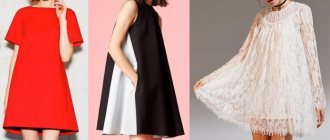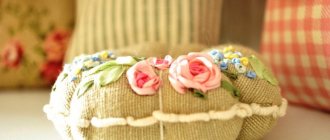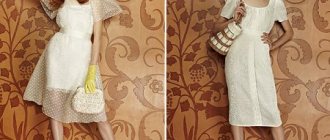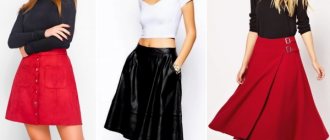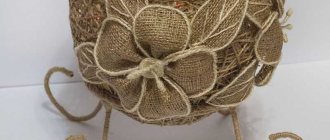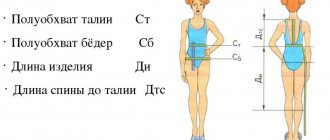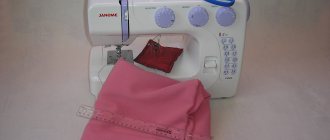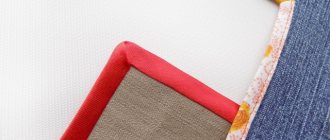Dear friends! I welcome everyone who has joined the open online project, which will take place from May 30 to June 5. All you need to participate is your desire to sew. I will publish materials about my sewing progress, waiting for your questions and additions. And photographs, of course! Together we will create a universal master class on a dress with the working title “Peasant Young Lady”
The materials in this article will be supplemented by our general developments.
So, I announce the beginning of a common project
The very first question: which model to choose? We see that they are all different both in cut and silhouette.
Cut-off at the waistline or not? With a full skirt or straight? With or without sleeves? Frill, flounce, or – ?
Which dress model do you like best?
Additionally, we need to take into account individual body shapes and strive for a feminine hourglass silhouette.
I settled on the following model:
- There is simply a gather along the top border of the dress, the neckline itself is shallow, slightly revealing the shoulders.
- The gathering of the bodice as a whole is sparse, with the back only slightly gathered, and the front and sleeves more voluminous. The gathers at the waist are minimal, the width of the waist dart opening.
- detachable skirt of the “Tatyanka” type, two-tiered with a frill at the bottom.
- sleeves to the elbow of the “flashlight” type.
Which dress did you choose? This is important to determine now because modeling and pattern making will vary greatly depending on the style chosen.
Choosing an off-shoulder dress model
It is important to first decide whether both shoulders will be open or just one.
And is there any additional support at the free edge? We can divide the whole variety of dresses
- there are no straps;
- straps available;
- The straps are tied around the neck or intertwined.
Advice! If you have broad shoulders, then you should not get carried away with dresses in the “Carmen” style.
A wide frill and flounce can successfully replace straps for us.
Skirts can also be different:
- One-piece straight or slightly flared.
- Tatyanka, godet, sun or bell skirt, cut at the waist.
Topical fabrics:
- sewing;
- batiste;
- guipure, lace;
- crepe;
- chiffon, georgette;
- thin knitwear;
- thin stretch denim.
Colors and patterns:
- strip;
- floral prints;
- plain fabrics of rich colors - red, black, green, royal blue, light blue, ocher.
Advice! If you have a “pear” figure, that is, narrow shoulders, wide hips, then this style is definitely for you!
Latest fashion trends
Nowadays it is very fashionable to wear shirt dresses. The style is reminiscent of a men's dress shirt: a turn-down collar, a placket and small buttons along the entire length of the dress. Typically, this style involves wide tailoring, with dropped shoulders, as if larger. The material used is natural, cotton or cambric. This makes the dress very light, loose, perfect for hot summer weather.
You can often see famous film and television stars wearing shirt dresses. They come in a variety of styles. Flared at the bottom, fitted and straight, with or without a belt. With pockets, a placket and a belt, they look strict. Suitable for work uniform or everyday life. Lightweight and flared models can be worn for a walk to the sea. Even shirt dress models with cut-out bare shoulders have been invented. Let's consider this option.
Calculation of suitable material
To sew a dress with open shoulders, we will need an amount of fabric equal to its length, plus a hem allowance of 10cm, plus the length of the frill or flounce. This is true for a fabric width of 140-150 cm.
With a smaller width, we need double the length. If your dress has sleeves, then add their length.
skirt
About the skirt: I will definitely make a cut-off skirt, because I want a full flowing skirt, and I want an almost fitted bodice. Therefore, I lowered the waist line by 5 centimeters so that there was a slight overlap over the elastic, and in general... I'll cut off the excess later if I don't need it.
Option for a one-piece dress without cutting at the waist: simply measure the length of the skirt strictly from the natural waistline. Set your measurement down from point B. Please note here: you will have to lower the waistline by 3-5 cm before this operation in order to create a free overlap over the elastic band. If the dress is without elastic (drawstring), then there is no need to make an allowance of 3-5 cm from the natural waistline.
Then flare the skirt to your liking, but make sure that the flare angle on the back and front matches. The side lines must be conjugate. And check the side and middle lines along the front and back: from the armhole line they should be equal. (segments AC and A1C1).
Like this:
My skirt will be two tiers. 1st tier. – one skirt panel per fabric width (150 cm) 2nd tier – a rectangle of fabric with a coefficient of 1.5 to the width of the upper tier. I like this kind of extension; I determined it for myself a long time ago through experience. Total: 150cm * 1.5 = 225 cm.
As for the length of the skirt, it’s not so simple. Your dress is up to you to decide.
I wanted a trendy midi this season. This is approximately 90 cm. I divide the length of the skirt into two parts: the overskirt and the frill. I determine the length of the frill using the method of the most favorable proportion: 60% - 40%. In all unclear cases, I resort to the “golden” design division of 60/40. A well-chosen proportion helps to visually elongate the figure, while an unsuccessful one completely kills all proportions. I don’t take risks and divide the skirt like this: 55cm / 35cm.
Even if you use ready-made patterns, it is still useful to understand “how it is made.”
Cutting off-shoulder dresses
If the cut is asymmetrical, then we cut only on fabric laid out in one layer.
- We fold the material in half, face to face (with a symmetrical arrangement of elements).
- Lay out the pattern pieces on the prepared fabric.
- We shallow it, not forgetting the seam allowances.
- Cut it out.
Important! We first check on a small piece of material to see if it is fading or shrinking.
Instructions for use
You can make a similar dress yourself. The stores sell a large number of simple, minimalistic models that would not hurt to decorate with an elegant frill. Purchase fabric of the required shade from a sewing boutique and sew it to the product. We talked about the features of the cut in one of the first sections of the article. If you want the shuttlecocks to be soft and smooth, make a large radius of the inner circle.
Popular articles Candy and bouquet surprise
For a walk
As for the style, you should be guided by the parameters of your own appearance and age. For example, young ladies with slender legs can afford a sexy mini, while older ladies are more likely to be more suited to discreet and elegant midis. For special occasions, you should purchase a floor-length satin robe.
Now it's the turn of the shoes. Beach and casual dresses are usually complemented with stylish flat sandals. You can also wear ballet flats if they do not have massive decoration on the toe.
For work, you can buy elegant pumps. With a small heel you will not feel tired, and its length does not contradict the strict rules of the dress code. In the summer, actively use sandals with a closed toe - this way none of your colleagues will see your pedicure.
Fashionable check
Feel free to use different accessories. A stylish bracelet on your wrist, sunglasses, a small handbag - this is something that any self-respecting fashionista should definitely have in her arsenal.
What about the cold season? Autumn is ahead with the first frosts, and then the frosty winter months. It's time to think about warm clothes. A dress made of light knitwear is considered the most successful solution. It goes well with fur coats, sheepskin coats, cropped jackets, trench coats, drape coats and even down jackets. Feet can be wrapped in leather boots with high, stable heels.
Perfect option
Airy and easy
The dress has always been an invariable attribute of a woman's wardrobe. Only it can amazingly transform your appearance, hide all the shortcomings and highlight the advantages. And such a trend as flounces was specially created in order to enhance girlish charms and make the image even more feminine and sexy. And don't forget about taking care of your skin. The décolleté area almost always remains open, and any pimple in the chest area can completely ruin the impression of you.
Sewing sequence
Required:
- Dress fabric according to calculations.
- Bias tape.
- Threads to match.
- Sewing machine.
Progress:
- We process darts, if any.
- We sew the back seam (if it is supposed to be in this model).
- Iron the seam allowances. We perform this procedure with each seam.
- We turn the drawstring and stitch it.
- We sew the front seam.
- Sew the side seams.
- If the skirt is stitched, then we sew the seams of the skirt, then sew it to the top.
- We bend the hem and stitch it.
- We process the cuts with bias tape, if necessary, use facings.
- We thread a lace or elastic band into the drawstring.
- Ironing.
- Let's try it on.
When making an off-the-shoulder dress, of course, you have to spend time, but the result is worth it.
In addition, this style offers a wide range of options, which is good news. Knitted mohair hat
How to felt a pig out of wool for beginners
How to make a frill
There are several ways to cut and sew a frill for the bottom of a dress. The following describes how to sew a flounce to the bottom of a dress in more detail.
For these purposes, you can use a frill cut in the form of a ring. In this case, the lower part will be wavy. How to sew a frill to the bottom of a dress: its inner part is attached to the bottom of the main part of the dress. Since the outer side of the flounce is wider, it will go in waves, giving the impression that the frill is flowing.
Various styles
A similar method is cutting in the form of a spiral.
You can make a flounce for a woman or girl by taking an even strip of fabric of the required width. However, it must be hemmed to the main part of the dress in a special way.
To do this, you need to act in accordance with the step-by-step instructions:
Shuttlecock assembly
The shuttlecock is folded into a ring. It is necessary to mark its middle. Make two seams along the edge with a wide stitch
This requires that the threads come out on both sides of each seam. It is important to ensure that the size of one part of the frill thus obtained matches the length of the back, and that of the other - with the front, taken along their lower edge. The threads need to be slightly tightened. In this case, it is necessary that the fabric in the form of a half-sun is positioned evenly. The frill should be basted onto the lower sections of the main part of the dress.
After that, it is attached and an overlock is done on the cuts.
Shuttlecock processing
The frills of the flounce cannot be ironed, because this will smooth out the folds on the skirt and the frill will lose its special, romantic look.
Shuttlecock attachment point
Important! You will need to make a double fold along the bottom edge. It can be sewn on a machine or done by hand using a blind seam
The allowances will need to be cut off. This is necessary to ensure that the thickness of the fabric does not become excessive.
Sometimes an elastic band is used in the shuttlecock.
A dress with a ruffled bottom is suitable for those women who want to emphasize that they are special. In this case, you need to carefully ensure that the figure matches this style. It must be remembered that the frills located at the bottom increase the visible volume of the hips and at the same time should emphasize the advantages of the figure. There are a large number of dresses with frills at the bottom, among which many women will find the most spectacular.
Ready-made patterns
For those who do not want to spend time creating patterns, there is a quick way with ready-made templates. Options may be different: product length, presence/absence of sleeves, sleeve length. On the Internet you can find a large number of different sheath dress patterns and choose the best option for yourself.
You may be interested in this: Making a terry robe with personalized embroidery
Important! When sewing, it is important to know your size, so it is recommended to use European size tables. You need to measure your own height, hips, waist and chest and choose the appropriate size.
Pattern No. 1
